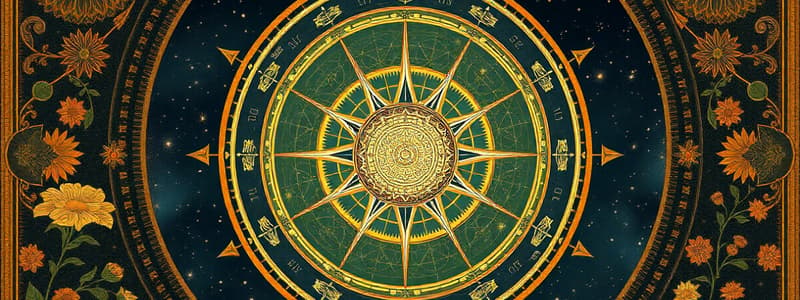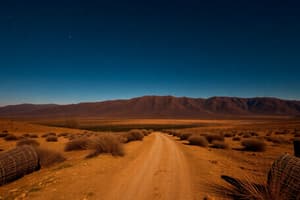Podcast
Questions and Answers
How would increasing Earth's axial tilt to 30 degrees affect seasonal temperature variations in the Northern Hemisphere?
How would increasing Earth's axial tilt to 30 degrees affect seasonal temperature variations in the Northern Hemisphere?
- It would eliminate seasonal changes altogether, resulting in a constant temperature year-round.
- It would increase the difference between summer and winter temperatures, leading to more extreme seasons. (correct)
- It would only affect the length of the days and nights but not the temperature differences.
- It would decrease the difference between summer and winter temperatures, leading to milder seasons.
If Earth's orbit were perfectly circular rather than elliptical, how would the timing of the solstices and equinoxes be affected?
If Earth's orbit were perfectly circular rather than elliptical, how would the timing of the solstices and equinoxes be affected?
- The timing of the solstices and equinoxes would become unpredictable, and the seasonal patterns would be disrupted.
- The timing of the solstices and equinoxes would be more evenly spaced throughout the year. (correct)
- The solstices and equinoxes would still occur at the same times of the year because they are solely determined by Earth's axial tilt.
- The solstices and equinoxes would no longer occur, as these are caused by the change in distance to the sun.
Suppose a planet has a 90-degree axial tilt. What would a year on this planet look like in terms of seasons at its equator?
Suppose a planet has a 90-degree axial tilt. What would a year on this planet look like in terms of seasons at its equator?
- Constant spring-like conditions throughout the year.
- Two summers and two winters each year, with milder temperatures in between. (correct)
- No distinct seasons at all, just gradual temperature changes.
- One extended summer and one extended winter each year, with abrupt transitions.
How would the experience of the December solstice differ for an observer located at the Arctic Circle compared to one at the North Pole?
How would the experience of the December solstice differ for an observer located at the Arctic Circle compared to one at the North Pole?
If Earth's axial tilt were to gradually decrease over thousands of years, what long-term effect would this have on the intensity of the seasons?
If Earth's axial tilt were to gradually decrease over thousands of years, what long-term effect would this have on the intensity of the seasons?
Considering both Stonehenge and Newgrange, what shared astronomical phenomenon dictated the design and purpose of these ancient structures?
Considering both Stonehenge and Newgrange, what shared astronomical phenomenon dictated the design and purpose of these ancient structures?
How does the lottery system for dawn admission to Newgrange during the winter solstice influence the experience and preservation of the site?
How does the lottery system for dawn admission to Newgrange during the winter solstice influence the experience and preservation of the site?
If a hypothetical ancient civilization were to construct a similar structure to Stonehenge or Newgrange in a region near the equator, what adjustments would be necessary to align it with a significant astronomical event?
If a hypothetical ancient civilization were to construct a similar structure to Stonehenge or Newgrange in a region near the equator, what adjustments would be necessary to align it with a significant astronomical event?
Considering the modern celebrations of the winter solstice in San Francisco and Anchorage, how do these events reflect different cultural adaptations to their respective geographical environments?
Considering the modern celebrations of the winter solstice in San Francisco and Anchorage, how do these events reflect different cultural adaptations to their respective geographical environments?
How might the contemporary understanding of astronomy influence or alter the experience of visiting ancient solstice sites like Stonehenge or Newgrange, compared to the experience of people in the past?
How might the contemporary understanding of astronomy influence or alter the experience of visiting ancient solstice sites like Stonehenge or Newgrange, compared to the experience of people in the past?
Flashcards
Winter Solstice
Winter Solstice
The astronomical start of winter, occurring on December 21.
Northern Hemisphere
Northern Hemisphere
The half of Earth above the equator experiencing winter solstice on December 21.
Southern Hemisphere
Southern Hemisphere
The half of Earth below the equator, celebrates summer solstice on December 21.
Earth's axial tilt
Earth's axial tilt
Signup and view all the flashcards
Solstices
Solstices
Signup and view all the flashcards
Stonehenge
Stonehenge
Signup and view all the flashcards
Newgrange
Newgrange
Signup and view all the flashcards
Yule
Yule
Signup and view all the flashcards
Winter Solstice Traditions in the US
Winter Solstice Traditions in the US
Signup and view all the flashcards




